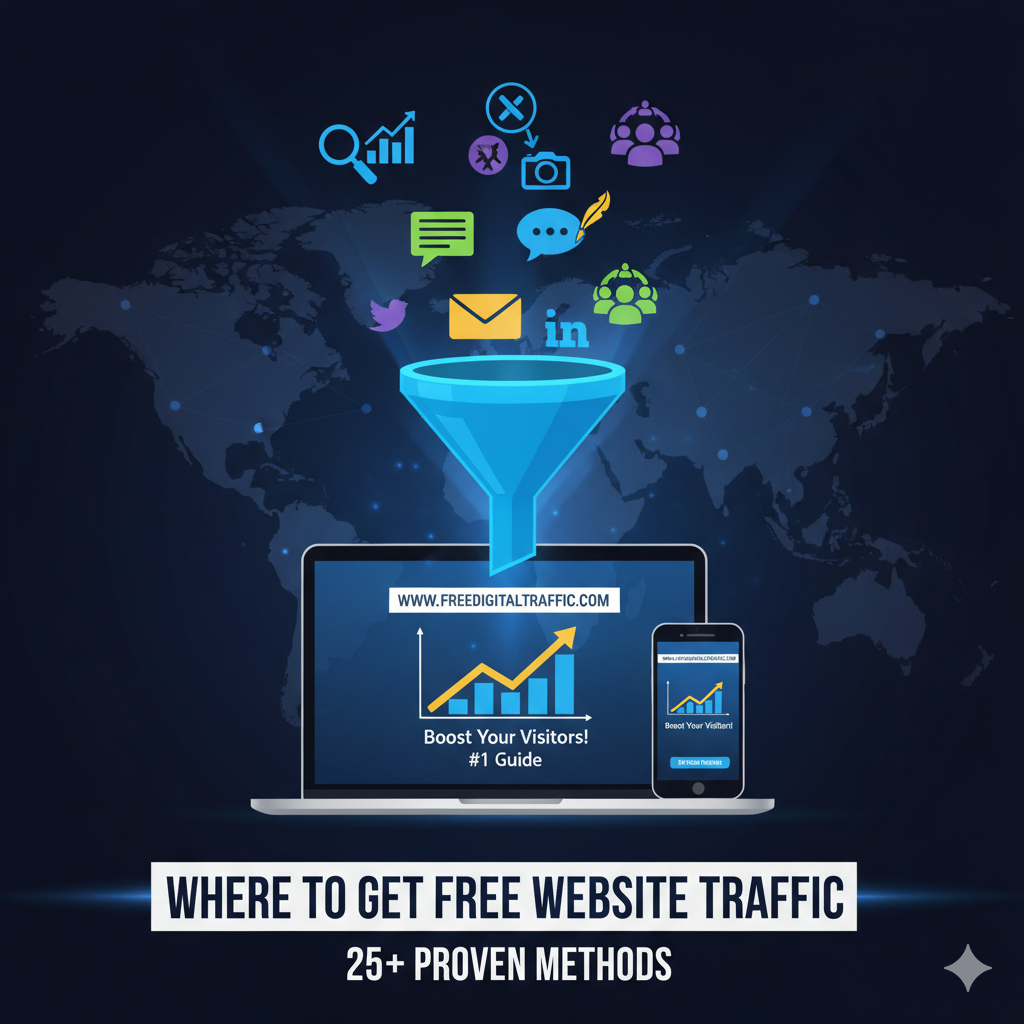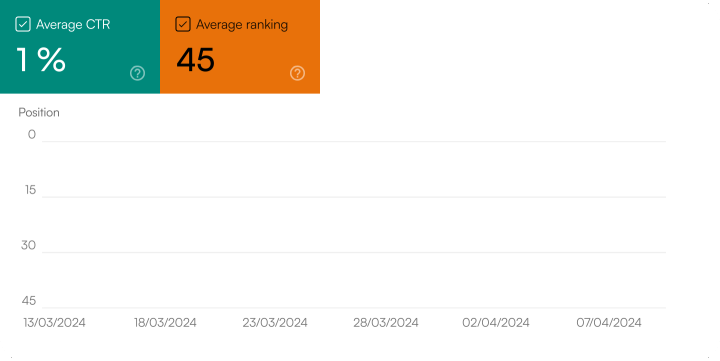
Where to Get Free Website Traffic: 25+ Proven Methods to Boost Visitors in 2025

Looking for ways to drive more visitors to your website without breaking the bank? You're in the right place! Getting free website traffic might sound too good to be true, but it's absolutely possible—and I'm about to show you exactly how.
In this comprehensive guide, you'll discover over 25 proven strategies to increase your website traffic without spending a penny on ads. Whether you're a small business owner, blogger, or entrepreneur, these methods will help you attract the right audience and grow your online presence organically.

Search Engine Optimization (SEO): Your Foundation for Free Organic Traffic
SEO is the cornerstone of free website traffic. When done right, it brings visitors to your site consistently without ongoing costs. Here's how to make it work for you.
Master Keyword Research
Before you write a single word, you need to know what your audience is searching for. Keyword research helps you understand the exact phrases people type into Google when looking for solutions you offer.
Start by brainstorming topics relevant to your business, then use free tools like Google Keyword Planner, AnswerThePublic, or Ubersuggest to find specific keywords. Look for terms with decent search volume but lower competition—these are your golden opportunities.
Pro tip: Focus on long-tail keywords (phrases with 3+ words) like "how to get free traffic to blog" instead of just "traffic." They're easier to rank for and attract more targeted visitors.
Optimize Your On-Page SEO
On-page SEO is about making each page on your website irresistible to search engines. This means crafting compelling title tags that include your target keywords, writing meta descriptions that make people want to click, and using header tags (H1, H2, H3) to structure your content logically.
Don't forget about your content itself! Write naturally while incorporating your keywords in the first 100 words, throughout the body, and in your conclusion. Make sure every image has descriptive alt text—this helps with accessibility and gives search engines more context about your content.
Improve Your Technical SEO
Technical SEO might sound intimidating, but the basics are straightforward. Ensure your website loads quickly by compressing images, enabling browser caching, and minimizing unnecessary code. A slow website frustrates visitors and hurts your rankings.
Mobile-friendliness is non-negotiable in 2025. More than half of web traffic comes from mobile devices, so your site must look great and function perfectly on smartphones and tablets. Use Google's Mobile-Friendly Test to see how you're doing.
Build Quality Backlinks for Free
Backlinks—when other websites link to yours—are like votes of confidence in Google's eyes. The more quality sites linking to you, the higher you'll rank.
Free backlink strategies that work:
Broken link building involves finding broken links on other websites and suggesting your content as a replacement. Use tools like Check My Links (a free Chrome extension) to find broken links on resource pages in your niche, then reach out politely offering your working link as an alternative.
Guest posting remains one of the most effective ways to earn backlinks and exposure. Identify blogs in your industry that accept guest posts, pitch them unique topic ideas, and include a link back to your site in your author bio or naturally within the content.
Resource page link building works because many websites maintain curated lists of helpful resources. Search for "your niche + resources" or "your niche + useful links" to find these pages, then reach out explaining why your content would be a valuable addition.
Claim Your Google Business Profile
If you have any local presence, claiming and optimizing your Google Business Profile (formerly Google My Business) is essential. It's completely free and helps you appear in local search results and Google Maps.
Fill out every section completely, add high-quality photos, encourage satisfied customers to leave reviews, and post regular updates. This simple step can drive significant free traffic from people searching for businesses like yours in their area.
Content Marketing: Creating Value That Attracts Visitors
Content marketing is about creating and sharing valuable content that naturally attracts your target audience. It's a long-term strategy that builds authority and trust while driving consistent free traffic.
Start a Blog and Publish Consistently
Blogging is one of the most powerful ways to generate free organic traffic. Each blog post is a new opportunity to rank for keywords and attract visitors from search engines.
Focus on creating high-quality, evergreen content—articles that remain relevant and useful for months or years. Answer your audience's questions thoroughly, provide actionable advice, and make your content more comprehensive than what's already ranking.
Consistency matters more than perfection. Whether you publish once a week or once a month, stick to a schedule so your audience knows when to expect new content.
Leverage Guest Blogging
Guest blogging serves double duty: you get a valuable backlink while exposing your expertise to a new audience. Look for established blogs in your niche that accept guest contributions.
When pitching guest posts, personalize each email, suggest specific topic ideas that would benefit their audience, and highlight your expertise. After your post goes live, promote it on your own channels and engage with comments to build relationships.
Create Engaging Videos
Video content is exploding, and YouTube is the second-largest search engine after Google. Creating videos related to your niche can drive substantial free traffic to your website.
You don't need expensive equipment—smartphone cameras are great these days. Focus on providing value: tutorials, how-tos, product reviews, or educational content your audience craves. Always include links to your website in video descriptions and encourage viewers to visit for more information.
Optimize your YouTube videos just like you would a blog post: use keyword-rich titles, write detailed descriptions, add relevant tags, and create eye-catching thumbnails.
Design Shareable Infographics
People love visual content, and infographics are incredibly shareable. Take complex information from your niche and present it in an attractive, easy-to-digest visual format.
Use free tools like Canva or Piktochart to design professional-looking infographics. Once created, publish them on your website, share them on social media, and submit them to infographic directories. Include an embed code so others can easily share your infographic while linking back to your site.
Launch a Podcast
Podcasting continues to grow in popularity, offering another channel to attract free website traffic. You can discuss topics related to your niche, interview experts, or answer audience questions.
The key is to create transcripts or detailed show notes for each episode and publish them on your website. This turns your audio content into SEO-friendly text that can rank in search engines, driving listeners to your site.
Offer Free Ebooks and Guides
Creating comprehensive ebooks or guides establishes you as an authority while providing immense value to your audience. Offer these as free downloads in exchange for email addresses, building your list while driving traffic.
Once someone downloads your guide, they'll likely explore more of your website. Plus, if your ebook is genuinely helpful, people will share it, bringing even more visitors your way.
Social Media Marketing: Free Traffic from Where People Already Are
With billions of active users across various platforms, social media represents a massive opportunity for free website traffic. The key is knowing where your audience hangs out and showing up consistently.
Choose the Right Platforms
Don't try to be everywhere at once. Focus on 2-3 platforms where your target audience is most active. B2B companies often find success on LinkedIn, while visual businesses thrive on Instagram and Pinterest. TikTok and YouTube are excellent for video content, while X (formerly Twitter) works well for real-time updates and conversations.
Optimize Your Social Media Profiles
Your social media profiles should clearly communicate what you do and include a link to your website. Use consistent branding across platforms, write keyword-rich bios, and make sure your profile is complete.
That link in your bio is valuable real estate—use it strategically. Link directly to your website homepage, a landing page, or use tools like Linktree to share multiple important links.
Post Valuable Content Regularly
Consistency is crucial on social media. Create a content calendar and stick to a regular posting schedule. Mix up your content types: share blog posts, ask questions, post behind-the-scenes content, share user-generated content, and provide quick tips.
The key is providing value rather than constantly promoting yourself. Follow the 80/20 rule: 80% valuable, educational, or entertaining content; 20% promotional.
Engage With Your Community
Social media is a two-way street. Don't just post and disappear—respond to comments, answer questions, and engage with other people's content. Join relevant groups and communities where you can participate authentically without spamming.
The relationships you build through genuine engagement often lead to the most loyal website visitors.
Use Hashtags Strategically
Hashtags help new people discover your content. Research relevant hashtags in your niche—aim for a mix of popular hashtags and more specific ones with less competition.
On Instagram, you can use up to 30 hashtags per post. On X and LinkedIn, 2-5 well-chosen hashtags work best. Create a branded hashtag unique to your business that customers can use when sharing their experiences.
Go Live With Webinars and Live Streams
Live video creates urgency and encourages real-time engagement. Host Q&A sessions, tutorials, product demonstrations, or interviews with experts. Promote your website during these sessions and direct viewers to specific pages for more information.
After going live, repurpose the recording as regular content, creating even more opportunities to drive traffic.
Create Shareable Content
Some content types naturally get shared more than others. Inspirational quotes, statistics, mini-tutorials, memes (if appropriate for your brand), and user-generated content all tend to perform well.
When your content gets shared, it exposes your brand to new audiences who may click through to your website.
Email Marketing: Your Direct Line to Website Visitors
Email marketing might seem old-school, but it's one of the most effective ways to drive free website traffic—once you've built a list.
Build Your Email List for Free
Start collecting email addresses from day one. Add signup forms to your website (header, sidebar, footer, and as pop-ups), offer valuable lead magnets like ebooks or checklists in exchange for email addresses, and include signup links in your social media bios.
Use free email marketing tools like Mailchimp, MailerLite, or Sender which offer free plans for smaller lists.
Send Valuable Newsletters
Regular newsletters keep your brand top-of-mind and drive consistent traffic back to your website. Share your latest blog posts, curate relevant industry news, offer exclusive tips, or provide special content just for subscribers.
Make sure every email includes clear calls-to-action that link back to your website. Whether it's "Read More" buttons or links to specific pages, make it easy for subscribers to click through.
Segment Your List
Not all subscribers are interested in the same things. Segment your email list based on interests, behavior, or demographics, then send targeted content to each group. This increases engagement and click-through rates because people receive content relevant to them.
Personalize Your Emails
Using someone's first name in your emails increases open rates. Most email marketing platforms make personalization easy. Beyond names, reference past purchases or content they've engaged with to make emails feel more personal and relevant.
Community & Forum Engagement: Building Relationships That Drive Traffic
Online communities are goldmines for free website traffic when approached correctly. The key is providing genuine value rather than just dropping links.
Answer Questions on Quora
Quora is a massive question-and-answer platform where people seek expert advice. Find questions related to your expertise, provide thorough, helpful answers, and include links to relevant content on your website when appropriate.
Build your Quora profile with a professional bio and link to your website. As you establish credibility by answering questions consistently, more people will click through to learn more about you.
Participate in Relevant Subreddits
Reddit has communities (subreddits) for virtually every topic imaginable. Find subreddits where your target audience hangs out and become an active, helpful member.
Important: Reddit users hate spam. Focus on genuinely participating in discussions, answering questions, and providing value. Only share links to your website when they're truly relevant and helpful to the conversation. Many subreddits have specific rules about self-promotion, so read them carefully.
Join Niche Forums
Beyond Reddit, countless niche forums exist for specific interests and industries. These tight-knit communities can be valuable sources of targeted traffic.
Create a complete profile with a link to your website, then participate regularly. Answer questions, start interesting discussions, and share your expertise. As you become a trusted community member, people will naturally click through to your website.
Comment Thoughtfully on Blogs
When you find blogs in your niche with active comment sections, join the conversation. Leave thoughtful, substantive comments that add to the discussion—not just "Great post!"
Many blogs allow you to include your website link with your comment. This creates a backlink (usually "nofollow," but still valuable) and exposes your brand to readers who might visit your site to learn more.
Other Creative Methods to Get Free Website Traffic
Beyond the major strategies, several creative approaches can drive additional free visitors to your website.
Submit to Online Directories and Listings
Online directories still matter, especially for SEO and local visibility. Submit your website to relevant directories in your industry. Start with the big ones—Google Business Profile, Bing Places, Yelp (if applicable)—then look for niche-specific directories.
These listings create backlinks and help people discover your business when searching directories directly.
Distribute Press Releases
While traditional press release distribution can be expensive, free options exist. Write newsworthy press releases about significant events, product launches, or milestones, then distribute them through free channels like PRLog, 24-7 Press Release, or Online PR Media.
Even if major news outlets don't pick up your story, these platforms create backlinks and potential visibility.
Form Strategic Partnerships
Collaborate with complementary businesses or influencers in your niche. Co-create content, cross-promote each other's work, or host joint webinars. These partnerships expose your brand to new audiences who are likely interested in what you offer.
Look for win-win opportunities where both parties benefit without exchanging money.
Create a Referral Program
Turn your existing customers and fans into traffic generators. Create a simple referral program that rewards people for sending new visitors or customers your way.
This can be as simple as offering discounts, exclusive content, or recognition for successful referrals. Make sharing easy by providing referral links and social sharing buttons.
Leverage User-Generated Content
Encourage your customers to create content featuring your products or services. Share their photos, videos, or testimonials on your website and social media (with permission). This not only provides social proof but also motivates others to engage with your brand hoping to be featured.
Create branded hashtags and run contests to generate more user content that drives awareness and traffic.
Optimize for Featured Snippets
Featured snippets—those highlighted answer boxes at the top of Google search results—drive significant traffic. Structure your content to answer specific questions clearly and concisely. Use numbered lists, bullet points, and direct question-and-answer formats.
When you land a featured snippet, you essentially rank above position #1, capturing tons of free traffic.
Best Practices for Maximizing Your Free Website Traffic
Regardless of which methods you choose, these best practices will help you get better results.
Focus on Quality Over Quantity
One comprehensive, valuable piece of content will drive more traffic than ten mediocre posts. Take time to research thoroughly, write clearly, and provide genuine value to your audience.
Quality content naturally attracts backlinks, social shares, and repeat visitors—all crucial for sustained free traffic.
Be Patient and Consistent
Free traffic strategies take time to gain momentum. SEO results typically take 3-6 months to materialize. Social media followings grow gradually. Email lists build slowly at first.
Don't get discouraged! Consistency compounds over time. Keep creating valuable content, engaging authentically, and implementing these strategies, and you'll see results.
Track Your Results
Use free analytics tools like Google Analytics and Google Search Console to monitor your traffic sources, popular content, and visitor behavior. This data helps you understand what's working so you can do more of it.
Set up goals in Google Analytics to track specific conversions—newsletter signups, contact form submissions, or product purchases—so you know which traffic sources deliver the best results.
Repurpose Your Content
Maximize the value of every piece of content by repurposing it across multiple channels. Turn blog posts into videos, infographics, social media posts, podcast episodes, or email newsletter content.
This multiplies your reach without creating everything from scratch, driving free traffic from various sources.
Build Relationships, Not Just Links
The most successful free traffic strategies focus on building genuine relationships with other content creators, influencers, and your audience. When you help others, provide value, and connect authentically, opportunities naturally arise.
People are more likely to share your content, link to your website, and recommend you to others when they know and trust you.
Optimize for Mobile Users
With more than half of web traffic coming from mobile devices, your website must provide an excellent mobile experience. Ensure fast loading times, easy navigation, readable text without zooming, and properly sized buttons and links.
Google prioritizes mobile-friendly websites in search results, so this affects both user experience and SEO.
Keep Learning and Adapting
Digital marketing evolves constantly. Algorithm updates change SEO best practices, new social media platforms emerge, and audience preferences shift. Stay informed about industry changes and be willing to adapt your strategies.
Follow reputable marketing blogs, join online communities, and experiment with new approaches while tracking results.
Your Action Plan for Free Website Traffic
Getting free website traffic doesn't happen overnight, but it's absolutely achievable with the right strategies and consistent effort. Here's how to get started:
Start with SEO fundamentals. Optimize your existing content, improve your site speed, and begin building quality backlinks. This creates a foundation for long-term organic traffic growth.
Choose 2-3 free traffic methods that align with your strengths and where your audience spends time. You can't do everything at once, so focus your efforts for maximum impact.
Create a content calendar and commit to consistent publishing. Whether it's blog posts, videos, or social media updates, consistency builds momentum.
Engage authentically in communities where your audience gathers. Provide value without expecting immediate returns, and watch relationships develop into traffic.
Track your progress using free analytics tools. Double down on what works and don't be afraid to abandon strategies that aren't delivering results.
Remember, the best time to start implementing these free traffic strategies was yesterday. The second-best time is right now. Choose one method from this guide and take action today—your future website traffic will thank you!
Which strategy will you try first? The opportunities for free website traffic are endless when you approach them strategically and consistently. Your audience is out there searching for exactly what you offer. Now you know how to help them find you.






